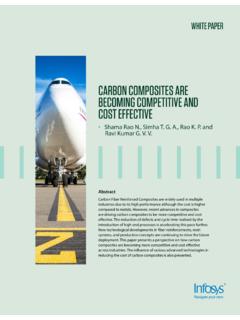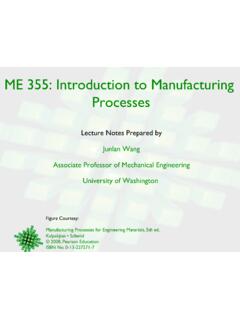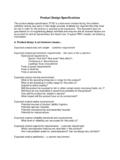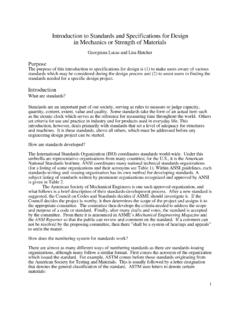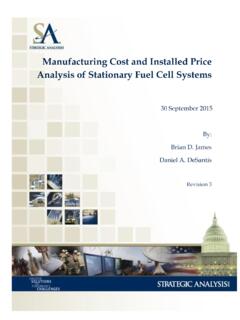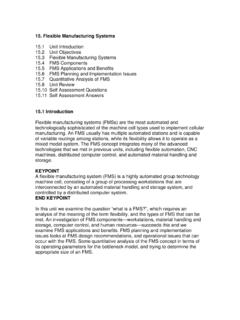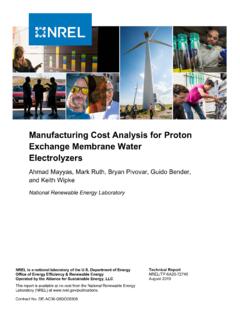Transcription of A Manufacturing Cost and Supply Chain Analysis of SiC ...
1 A Manufacturing cost and Supply Chain Analysis of SiC. Power Electronics Applicable to Medium-Voltage Motor Drives Kelsey Horowitz, Timothy Remo, and Samantha Reese National Renewable Energy Laboratory CEMAC is operated by the Joint Institute for Strategic Energy Analysis for the Department of Energy's Clean Energy Manufacturing Initiative. Technical Report NREL/TP-6A20-67694. March 2017. Contract No. DE-AC36-08GO28308. A Manufacturing cost and Supply Chain Analysis of SiC Power Electronics Applicable to Medium-Voltage Motor Drives Kelsey Horowitz, Timothy Remo, and Samantha Reese National Renewable Energy Laboratory Prepared under Task No. CEMAC is operated by the Joint Institute for Strategic Energy Analysis for the Department of Energy's Clean Energy Manufacturing Initiative.
2 Clean Energy Manufacturing Technical Report Analysis Center NREL/TP-6A20-67694. 15013 Denver West Parkway March 2017. Golden, CO 80401. 303-275-3000. Contract No. DE-AC36-08GO28308. NOTICE. This report was prepared as an account of work sponsored by an agency of the United States government. Neither the United States government nor any agency thereof, nor any of their employees, makes any warranty, express or implied, or assumes any legal liability or responsibility for the accuracy, completeness, or usefulness of any information, apparatus, product, or process disclosed, or represents that its use would not infringe privately owned rights. Reference herein to any specific commercial product, process, or service by trade name, trademark, manufacturer, or otherwise does not necessarily constitute or imply its endorsement, recommendation, or favoring by the United States government or any agency thereof.
3 The views and opinions of authors expressed herein do not necessarily state or reflect those of the United States government or any agency thereof. Available electronically at SciTech Connect: Available for a processing fee to Department of Energy and its contractors, in paper, from: Department of Energy Office of Scientific and Technical Information Box 62. Oak Ridge, TN 37831-0062. OSTI Phone: Fax: Email: Available for sale to the public, in paper, from: Department of Commerce National Technical Information Service 5301 Shawnee Road Alexandria, VA 22312. NTIS Phone: or Fax: Email: Cover Photos: (left to right) iStock 2225189; iStock 16687273; Oak Ridge National Laboratory; iStock 24304597; iStock 26005993;. iStock 2069560.
4 NREL prints on paper that contains recycled content. Acknowledgments This work was supported by the Advanced Manufacturing Office in the Department of Energy's Office of Energy Efficiency and Renewable Energy under contract number DE-AC36- 08GO28308. We would also like to acknowledge Alfred Hicks (NREL), who created the chip process flow diagrams, and Billy Roberts (NREL), who made the SiC wafer and device map. iii This report is available at no cost from the National Renewable Energy Laboratory at Nomenclature or List of Acronyms DCF discounted cash flow kV kilovolt MOSFET metal-oxide semiconductor field-effect transistor MSP minimum sustainable price NREL National Renewable Energy Laboratory R&D research and development SBD Schottky barrier diode SG&A sales, general, and administrative Si silicon SiC silicon carbide VFD variable frequency drive WACC weighted-average cost of capital iv This report is available at no cost from the National Renewable Energy Laboratory at Abstract Wide bandgap semiconductor devices are increasingly being considered for use in certain power electronics applications.
5 Where they can improve efficiency, performance, footprint, and, potentially, total system cost compared to systems using traditional silicon (Si) devices. Silicon carbide (SiC) devices in particular which are currently more mature than other wide bandgap devices are poised for growth in the coming years. Today, the Manufacturing of SiC. wafers is concentrated in the United States, and chip production is split roughly equally between the United States, Japan, and Europe. Established contract manufacturers located throughout Asia typically carry out Manufacturing of wide bandgap power modules. By modeling regional cost drivers under different scenarios, we illustrate regional cost drives and provide an overview of global Supply Chain issues to help elucidate key factors that may influence Manufacturing location investment decisions.
6 We conduct this Analysis for a particular case study where SiC devices are used in a medium-voltage motor drive. v This report is available at no cost from the National Renewable Energy Laboratory at Table of Contents 1 Introduction .. 1. 2 The Current Supply Chain for SiC-Based VFDs .. 2. Methodology for Selecting Materials for Supply Chain 2. Raw 2. Processed Materials .. 3. SiC Substrates/Wafers .. 3. SiC Chips .. 5. SiC Power 5. SiC-Based VFDs .. 6. 3 Regional cost Analysis .. 7. cost Analysis Methodology .. 7. Regional cost Model Results .. 17. 4 Summary .. 26. References .. 28. Appendix A. Detailed Input 31. Appendix B. Breakdown of Module Material Costs .. 33. vi This report is available at no cost from the National Renewable Energy Laboratory at List of Figures Figure 1.
7 Simplified value Chain diagram for SiC-based VFDs .. 1. Figure 2. Map of global production of SiC wafers (substrates and epi-wafers) and devices with locations of SiC epi- fab facilities in 3. Figure 3. Manufacturing process flow used for calculating the costs associated with growing a SiC boule, creating SiC substrates from the boule, and epitaxially growing SiC on the substrate to create the epi-wafer .. 10. Figure 4. Manufacturing process flow used for calculating the costs associated with Manufacturing SiC MOSFETs (top) and SBDs (bottom) .. 12. Figure 5. Manufacturing process flow used for calculating the costs associated with the SiC power module.. 15. Figure 6. MSP breakdown by country for the SiC epi-wafers in the base case.
8 18. Figure 7. Comparison of China and modeled MSPs in our two hypothetical scenarios: (top) scenario #1 and (bottom) scenario #2. Details of the assumptions made in each scenario are included above.. 21. Figure 8. MSP breakdown by country for a SiC MOSFET (top) and SBD (bottom) in the base case .. 22. Figure 9. MSP breakdown by country for the SiC power module .. 24. Figure 10. MSP breakdown by country for the SiC-based VFD .. 25. Figure 11. Breakdown of the material costs for the SiC-based VFD by category .. 25. Figure 12. Summary of modeled MSP results and key factors across the value Chain . The value and share for each element are shown for the case of Manufacturing .. 26. Figure B-1. Material cost breakdown for the SiC power modules.
9 33. vii This report is available at no cost from the National Renewable Energy Laboratory at List of Tables Table 1. Manufacturing Locations for Medium-Voltage Power Modules (Mostly Used for Si Power Modules Today). for Several Leading Companies .. 6. Table 2. Country Factors for Countries Included in this Analysis .. 8. Table 3. Key Parameters of the SiC Wafer Modeled .. 10. Table 4. Key Financial Assumptions for the SiC Wafer DCF Model .. 11. Table 5. SiC MOSFET and SBD Design 13. Table 6. Key Financial Assumptions for the SiC Chip DCF Model .. 14. Table 7. Bill of Materials for the VFD .. 16. Table 8. Key Financial Assumptions for VFD DCF Model .. 17. Table A-1. Key Input Assumptions used in the SiC Wafer Manufacturing cost Model.
10 31. Table A-2. Assumptions for the Hypothetical, Example Regional cost Scenarios for SiC Wafers .. 31. Table A-3. Key Input Assumptions Used in the SiC MOSFET Manufacturing cost Model .. 32. Table A-4. Key Input Assumptions for the VFD cost Model .. 32. viii This report is available at no cost from the National Renewable Energy Laboratory at 1 Introduction Machine drives have historically constituted the single largest end use of electricity in the Manufacturing sector (Unruh 2003). In cases where loads are variable, power electronics-based variable frequency drives (VFDs) are more efficient than the systems employing relatively inefficient gearboxes and mechanical throttles that typically used today. The use of wide bandgap (WBG) semiconductors can provide an additional boost to VFD efficiency, as well as allow them to operate efficiently at higher voltages, powers, temperatures, and switching frequencies.










